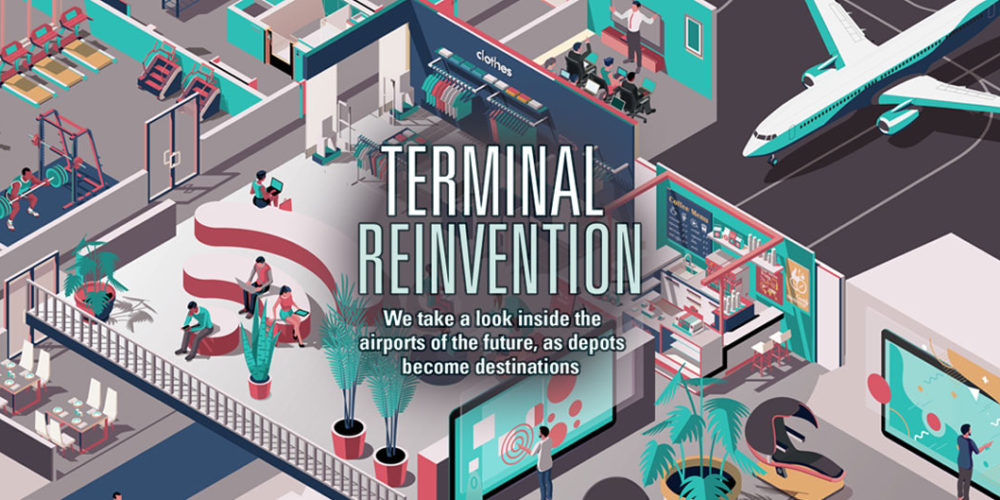Airports aren’t just airports anymore. What used to be a utilitarian jumping off and landing point for air travelers has become a mecca of experiential commerce. Today’s passengers enjoy upscale dining and shopping options, conduct meetings in business-ready conference rooms, get spa treatments, and even catch some zzzs in sleep pods — without ever leaving the terminal.
All of these upgrades are about much more than making travel more pleasant. They underscore a growing financial challenge. With more people and cargo flying, the nation’s aging aviation infrastructure is struggling to keep up. To meet the growing demand, airport managers must expand and enhance their aeronautical operations and customer service facilities. The problem is, only one of these things — customer service — is profitable for the airport.
Enter the next wave of airport innovation. Airport managers are banking their futures on turning “depots” into destinations, where travelers can turn a time-killing layover into an experience to remember.

Open Skies, Crowded Airports
Mike Ehl (’83), director of aviation operations for Seattle-Tacoma International Airport (SEA-Tac), says there is an inescapable irony to air travel today.
People are flying in style on new, modern aircraft with in-flight entertainment and technological advancements that enhance the passenger experience, he says. However, when these same passengers embark and land, they typically walk through outdated, congested airport facilities that are more than 40 years old.
Ehl says SEA-Tac — recently named the eighth largest airport in the country — is a case in point.
“We’ve grown 45% in the last five years,” Ehl says. “We’re 70 years old. We have crossed the threshold, now, where the level of service is disappointing at best.”
What’s more, there is no slowdown coming. “It’s all deregulated, and [any airline] can come day or night. It’s pretty much open skies. … It’s a real challenge nationwide, and I don’t think anyone was prepared for it,” he says.
Kim Becker (’97), president and CEO of the San Diego County Regional Airport (SAN) Authority, says SAN is also struggling to keep up with the influx of passengers. “We’ve had five years of record growth,” she says. “Last year (2018) we hit 24 million passengers. The year before (2017), we were at 22 million. That was on top of four previous years of growth.”
Did you know?
Embry-Riddle’s David B. O’Maley College of Business hosts the annual Air Transport Research Society (ATRS) Airport Benchmarking Report: Global Standards for Airport Excellence. Students collect and compile the data, conduct analysis and generate the annual report under the supervision of Benchmarking Task Force Research Director Chunyan Yu, professor of air transport management. The 2019 report includes an assessment of 204 airports and 24 airport groups located in Asia Pacific, Europe and North America.
Becker and SAN are not alone. The Airports Council International-North America (ACI-NA) projects that by 2023, commercial airports in the United States will need more than $128 billion in infrastructure upgrades and maintenance.
Citing this figure and the most recent American Society of Civil Engineers’ Infrastructure Report Card (2017) that gave U.S. airports a just-passing ‘D’ grade, Liying Gu (’02), vice president for economic affairs and research at ACI-NA says, “We really need to spend more money. We need more investment.”
Vishal Amin (’01), aviation commissioner for the state of Maryland and CEO of Aertron, agrees. “If we are going to be a 21st century economy, we need to continue to invest in new infrastructure to support innovation and new technologies, such as autonomous vehicles, urban air mobility and the integration of unmanned aircraft systems.”
Financing the Future
To secure investment to finance airport growth, airport managers have relatively few choices. The federal government is a key player, but investments have been flat, at best. The total grant money provided through the Airport Improvement Program (AIP) — a competitive program that supports Federal Aviation Administration-approved projects and is funded by airline and fuel taxes and other user fees — has not grown with air passenger and cargo demand.
“It’s great to have $3.1 to $3.4 billion allocated to the airports, but … if you look back at AIP grants in general over the last 15 years, the allocated amount has been pretty well the same,” says Zachary Oakley (’16), deputy director of operations and planning for the Greater Rockford Airport Authority/Chicago Rockford International Airport (RFD).
Adjusted for inflation, this amounts to a 25% loss in buying power from 2004 to 2018, according to the Bureau of Labor Statistics.
Government has taken notice of the funding challenge. In 2019, the Department of Transportation distributed $779 million in supplemental grants to 127 airports — in addition to the $3.1 billion awarded the previous year through AIP.
Another airport funding stream — the passenger facility charge — could help support infrastructure projects, but it’s currently constrained by an Act of Congress. [See sidebar: Finance Battleground.]
The Customer Is King
Airports aren’t waiting on a hand up from the government, though. With an increasing number of customers at the gates, many of the major hubs are renovating and expanding — placing an emphasis on how those customers experience their time between flights. It’s all in an attempt to increase non-aeronautical revenue, which is one of the keys to helping finance future infrastructure improvements.
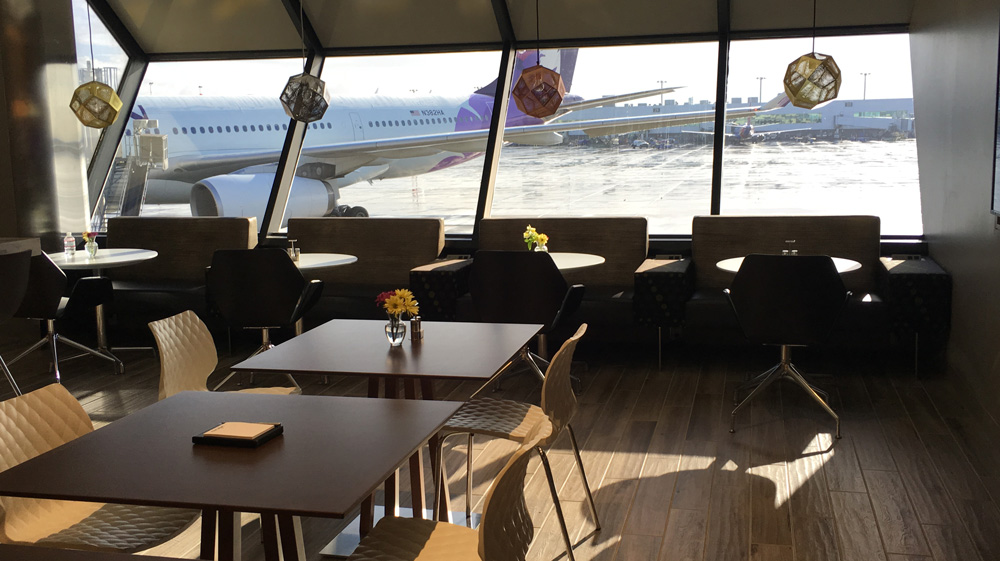
“The aeronautical side is a cost-recovery model for U.S. airports,” Gu says. It includes charges collected from the airlines, cargo and general aviation activities, and fixed-base operations. The U.S. government does not allow airports to make a profit on this income. “But on the non-aeronautical side, that’s where innovation comes in,” she says. In addition to traditional non-aeronautical sources like parking and rental car fees, airport managers can turn to a range of experiential enhancements. “By offering more choices, more convenience, embedding technology and making the environment more appealing, the airport can generate more revenue from the food and beverage, and retail and services aspects,” Gu says.
SEA-Tac is investing in its airport infrastructure to the tune of $3.2 billion, with most of this investment focusing on the customer experience. Improvements include a 201,000-square-foot addition to the North Satellite/Alaska Airlines Terminal, a new 450,000-square-foot, multi-level International Arrivals Facility, and a 10,000-square-foot expansion of the Central Terminal. The projects add dining and shopping options, seating and aesthetic enhancements, and a new premium customer lounge for Alaska Airlines.
Story continues below box. Jump
Finance Battleground
Airlines and Airports Face Off Over Passenger Facility Charges
Those working in the aviation industry largely agree that U.S. airports need to renovate and grow. But that’s where the agreement ends. Airports and airlines have argued for the last decade or more about how best to accomplish this growth.
The root of the argument is the passenger facility charge (PFC).
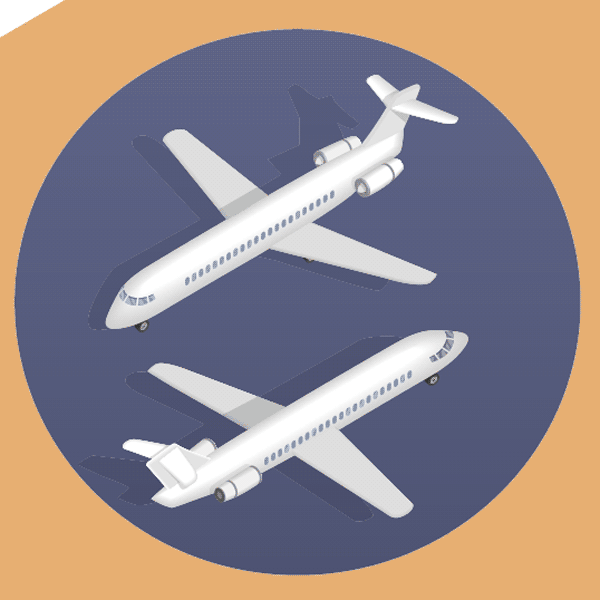
Since 2001, an Act of Congress has capped the PFC at $4.50 per flight segment (for a maximum of $18 total for a round trip), per passenger. Airports use PFCs to pay off debt and as backing to issue bonds to finance improvements, says Liying Gu (’02), vice president for economic affairs and research at ACI-NA. This “artificial cap,” Gu says, is interfering with airports’ ability to make necessary facility improvements.
“There is a bit of a battle between airports and airlines,” says Kim Becker (’97), president and CEO of the San Diego County Regional Airport Authority. The airlines maintain that airports can pay for infrastructure projects through partnership agreements with them, while airports, as good neighbors, must consider what’s right for the community as well, Becker says.
According to Airlines for America (A4A), an airline advocacy group, PFCs are an “airport tax” on the traveling public and increasing the PFC could affect consumers’ decisions to fly.
But Zachary Oakley (’16), deputy director of operations and planning for the Greater Rockford Airport Authority/Chicago Rockford International Airport, says, “The airlines have no problem arbitrarily raising baggage fees, seat fees or any other fees they want to tack on to the ticket price,” with no regulatory oversight. Despite the growing number of ancillary fees, 777.9 million* passengers flew on domestic flights in 2018, an increase of 4.9% over 2017.
The ACI-NA is lobbying Congress to increase the PFC cap. “We’re hoping that the upcoming infrastructure package or other legislative vehicles would include a provision to allow the airports to charge a higher rate,” Gu says.
*U.S. Department of Transportation, Bureau of Transportation Statistics
“The passenger experience is vastly improved in Terminal 2. Terminal 1 was built in 1967, and we are planning for its replacement,” Becker says. The proposed Terminal 1 project would include 30 gates (to replace the current 19-gate facility) and cost an estimated $3 billion. The environmental study for the project is currently underway.
SAN and SEA-Tac are just the tip of the iceberg when it comes to current airport renovations. Los Angeles International Airport is in the midst of a $14 billion infrastructure improvement project; Chicago O’Hare Airport recently started an $8.7 billion expansion; and JFK in New York is planning to spend $10 billion on its remodel.
Smaller airports are also investing in passenger-oriented facilities. For example, Oakley says, RFD will complete a $25 million, three-year terminal expansion project in 2020.
In the last 15 years, RFD has gone from serving 60,000 passengers a year to roughly 240,000, Oakley says. “Our terminal was originally built for 19- to 30-seat aircraft, ground boarding, without TSA. It was definitely processing things it was never intended to process.”
Innovating the Customer Experience
Customers are driving these improvements, says Assistant Professor of Aerospace and Occupational Safety E. David Williams. “Traveling now is more of an experience, as well as a necessity. People are demanding a higher level of service,” he says.
For example, premium lounges that offer relaxed seating, complimentary snacks and beverages — and sometimes sleep pods — for a fee are becoming popular, as are lounges designated for spa services, smokers and people traveling with pets.
Airports are also installing fee-based conference rooms, so business travelers can choose to meet at the airport and avoid the added expense of rental cars and overnight accommodations, Williams says. “The airports have become more than just an airport.”
Bryant Francis (’98), director of aviation for the Port of Oakland/Oakland International Airport (OAK), agrees. “Customers today have far greater expectations of the airport experience than in years past, and we are stepping up our efforts to deliver.” Francis says the Escape Lounge at OAK has been very successful. A premium, fee-based space, the lounge offers food and beverages, as well as business amenities, charging stations and access to high-speed internet and complimentary tablets. Operated by an outside vendor, the lounge generated more than $300,000 in non-aeronautical revenue for the airport in 2018, Francis says.
Other customer experience initiatives at OAK include a renovation and rebranding of all 17 food and beverage concessions terminal-wide, the first of which are expected to debut in late 2019; new gate hold-room seating; restroom renovations; an automated exit lane system for arriving customers transitioning from gate areas to baggage claim and new concourse flooring, both located in Terminal 2.
Becker says she and her team are making a concentrated effort to improve the customer experience at SAN, as well.
“SAN doesn’t have an incredible amount of on-airport parking; what we have to do as an airport is to find new and creative ways to increase that non-airline revenue.”
Inventing New Revenue Streams
One way SAN is elevating its bottom line is by making inventive use of its former commuter terminal, which now houses what Becker calls the Innovation Lab. At the lab, SAN invites businesses and entrepreneurs to develop and test products at the airport. During a 16-week program, airport staff guide selected ideas from prototypes to a test market.
“It’s in a real-time environment where they can come in and work out all the bugs for their system,” Becker says. If the products prove successful, SAN may contract with them for the service; and if it expands to other airports, SAN recuperates a small percentage or royalty.
The program has already had its first success: An app called At Your Gate, which launched Jan. 31, 2018. The app allows passengers at any location in the airport to order food or retail items from any other terminal and have them delivered to them. “It started here, and now it’s in five other airports across the country,” Becker says.
Story continues below box. Jump
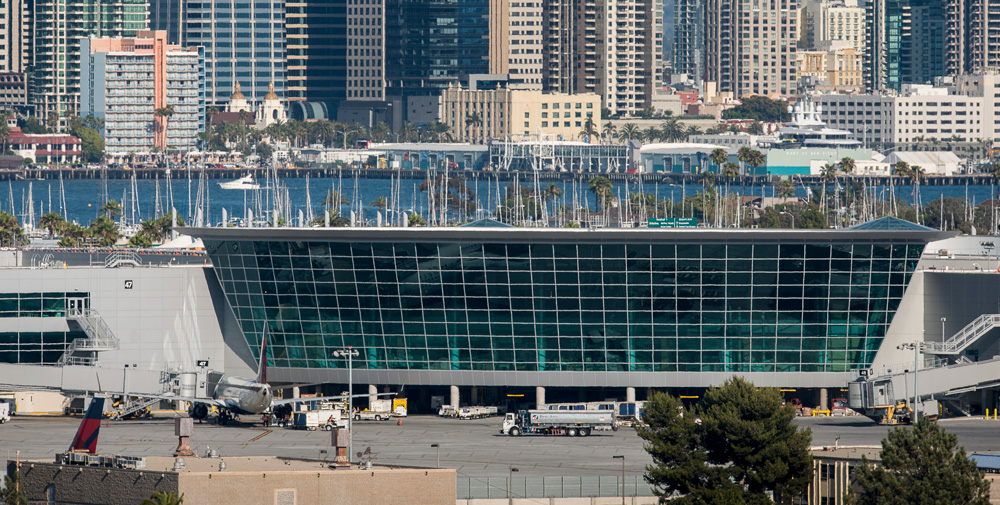
From Smart Windows to Biometrics
Technological Advancements Promise to Revolutionize the Airport Experience
Airports are not only enlarging and modernizing the physical attributes of terminals — they’re also adding technological systems to streamline their customer services. Many of these improvements revolve around data collection and analysis.
Liying Gu (’02), vice president for economic affairs and research at ACI-NA, says windows with integrated beacons and sensors have been installed at some airports and others will soon follow suit. These “smart windows” are able to track customer traffic and activity.
“Dallas/Fort Worth Airport is investing in these windows,” Gu says. “They are trying to figure out better ways to use all of the data to better manage passenger flow.”
Embry-Riddle Professor of Air Transport Management Chunyan Yu says airports are also monitoring passengers via their internet usage. “These days, airports can use social media to track passenger movement. Some are using Wi-Fi activity to determine when they need to open security lanes. If you have an airport app on your phone, it can also push location-based ads as you move through the airport,” she says.
Wayfinding applications are also becoming popular at airports, allowing passengers to navigate the terminals and search for their favorite restaurants and retail outlets by using their smartphones. These apps give airports additional data on passenger congestion.
With all of this data flowing in, Gu says the data analyst is now a common employee working behind the scenes at the airport. “They need people who can digest all of this data to help them make more informed decisions,” she says.
Bag Tracking
Lost bags are not only a major hassle, they are also a major cost. Radio frequency identification (RFID) technology used to tag and track bags promises big improvements over the hand-scanned barcodes that have been the industry standard since the 1990s.
A report by SITA (Société Internationale de Télécommunications Aéronautiques) in 2017 found that the U.S. air transport industry could save $3 billion in lost baggage costs with RFID tracking. Delta Air Lines was the first U.S. carrier to start using RFID tags on luggage in 2016.
“The RFID technology seems like it’s from a decade ago, but the efficiencies that can be gained are huge,” says Director of the Prescott Campus School of Business Tom Drape.
Biometrics
Biometrics is the next thing that will speed up the flow of passengers and baggage through airports, Drape says. “With biometrics, you have less need for individuals to show IDs at touchpoints at the airport. It might be face recognition, fingerprinting or retinal scans. China, Singapore, Turkey and Dubai all do some form of this.”
Kim Becker (’97), president and CEO of the San Diego County Regional Airport (SAN) Authority, says SAN recently integrated facial recognition into its federal inspection service for international arrivals. The technology operates in concert with a U.S. Customs and Border Protection database. “It’s really streamlined the processing time,” Becker says. “They took out all of the automatic passport kiosks that we planned and built space for, and we were able to use this biometric technology and bypass this whole step.”
Eventually, she says, the TSA could use biometrics to vet passengers in advance, to expedite the domestic security process. “That kind of technology will really revolutionize airports.”
Drape says technological advancements like these will vastly improve the customer experience and help airports with their bottom line. “Airports feel better when passengers spend less time in lines, because more people spend time buying and eating things,” he says.
Creative Solutions
Airports are also funding their infrastructure needs with help from public-private partnerships (P3). “There are many companies looking for opportunities to partner with airports,” Gu says.
SAN partnered with a private business to help build a new $19.2 million centralized receiving and distribution center, which began operating in 2012. However, the airport authority decided not to pursue a P3 for its Terminal 1 replacement. These types of partnerships are situational and not always in the best interest of airports for all projects, Becker says. “You do give up some aspect of control of the facility.”
Did you know?
Branson Airport in Missouri is the only privately owned and operated airport in the United States. Embry-Riddle alumnus Jeffrey Bourk (’95) is the airport’s executive director.
Smaller airports are capitalizing on niche markets to generate profits. For example, Leadville-Lake County Airport (LXV) in Colorado relies on its 9,934-foot elevation to generate income from helicopter testing companies. They come to LXV to define the maximum performance lift capabilities of their aircraft at maximum altitude, says LXV Airport Manager Brett Cottrell (’96, ’97). Additionally, a gift shop geared to its claim as “America’s highest airport” helps supplement the airport’s operational expenses and fund improvements.
“We are the highest [altitude] public-use airport and the highest incorporated town in the United States,” Cottrell says. “Landing here is on a lot of people’s bucket lists.”
Large hubs are getting creative with the use of hardstands to help deal with gate shortages, as well. At OAK, Francis recently invested in three Cobus 3000 buses to transport passengers to and from hardstand, remote aircraft parking spots. “This will provide a bit of flexibility during peak periods of flight activity,” he says.
SEA-Tac is regularly using hardstands to deal with its gate shortage, Ehl says.
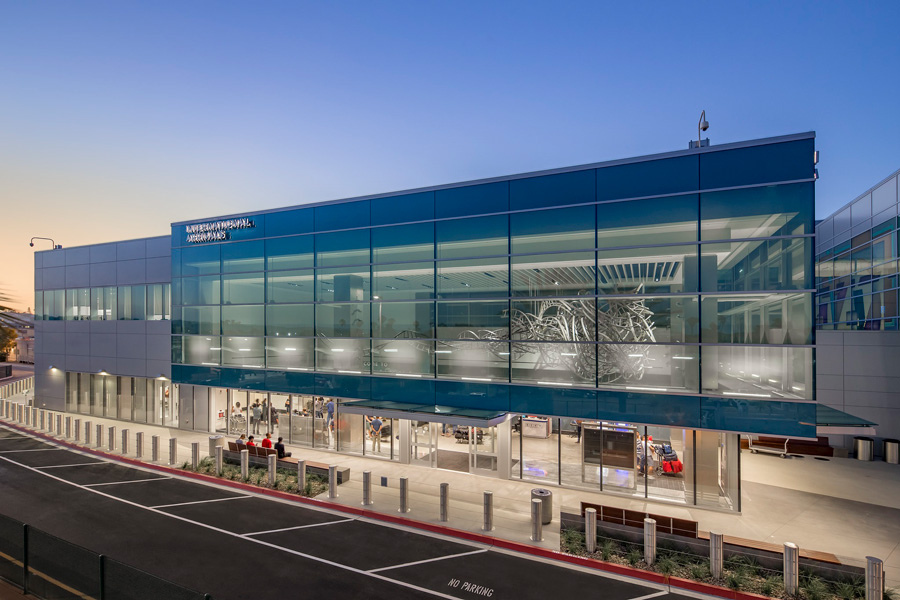
Rising to the Challenge
Increasing non-aeronautical revenue, improving the customer experience and renovating and expanding terminal facilities are all positive efforts for the airport industry, but Ehl, who retired in June 2019 after 27 years at SEA-Tac, says airports may ultimately need to look to each other to handle the growing number of passengers.
“Given the current growth trend and our capacity constraints, [SEA-Tac is] going to be maxed out in three years,” he says. However, there are three airports, operated by three different political entities in the Puget Sound area. “Theoretically, if they were balanced in a system, we’d have capacity.”
Amin agrees: “As the demand on hub-international airports grows, I believe the only way to continue to support the growth of our industry is to utilize strategically located regional airports near the hub airports to help alleviate some of the congestion.”
Despite the many challenges facing the nation’s airports, Amin has no doubt that the industry will address the need. “I believe humans, when given a challenge, always rise to it,” he says.
